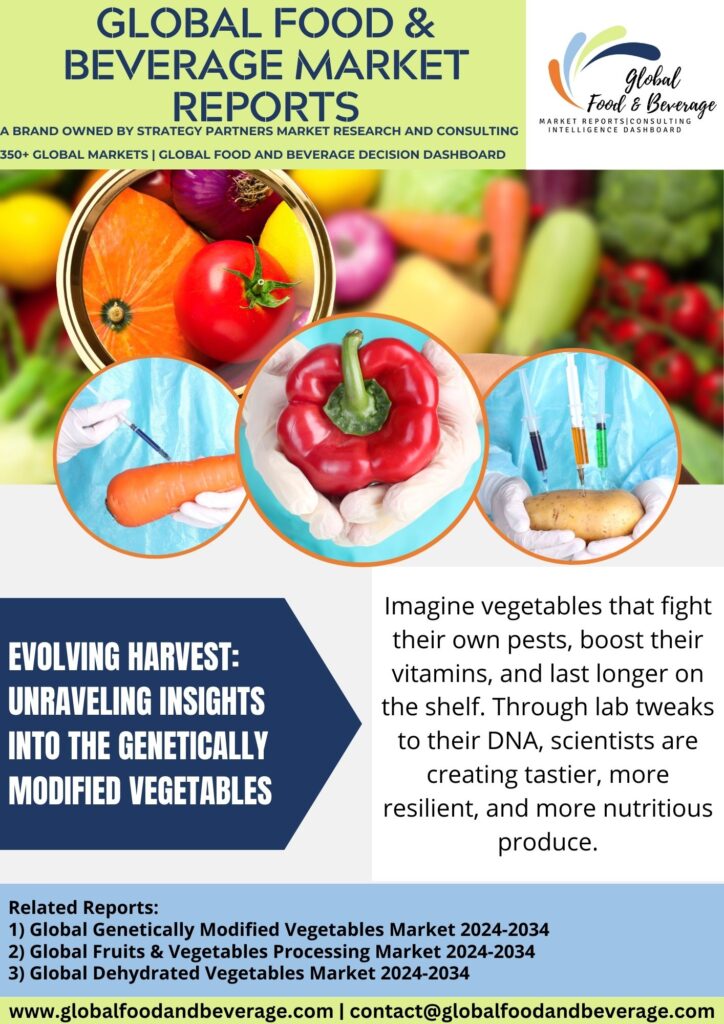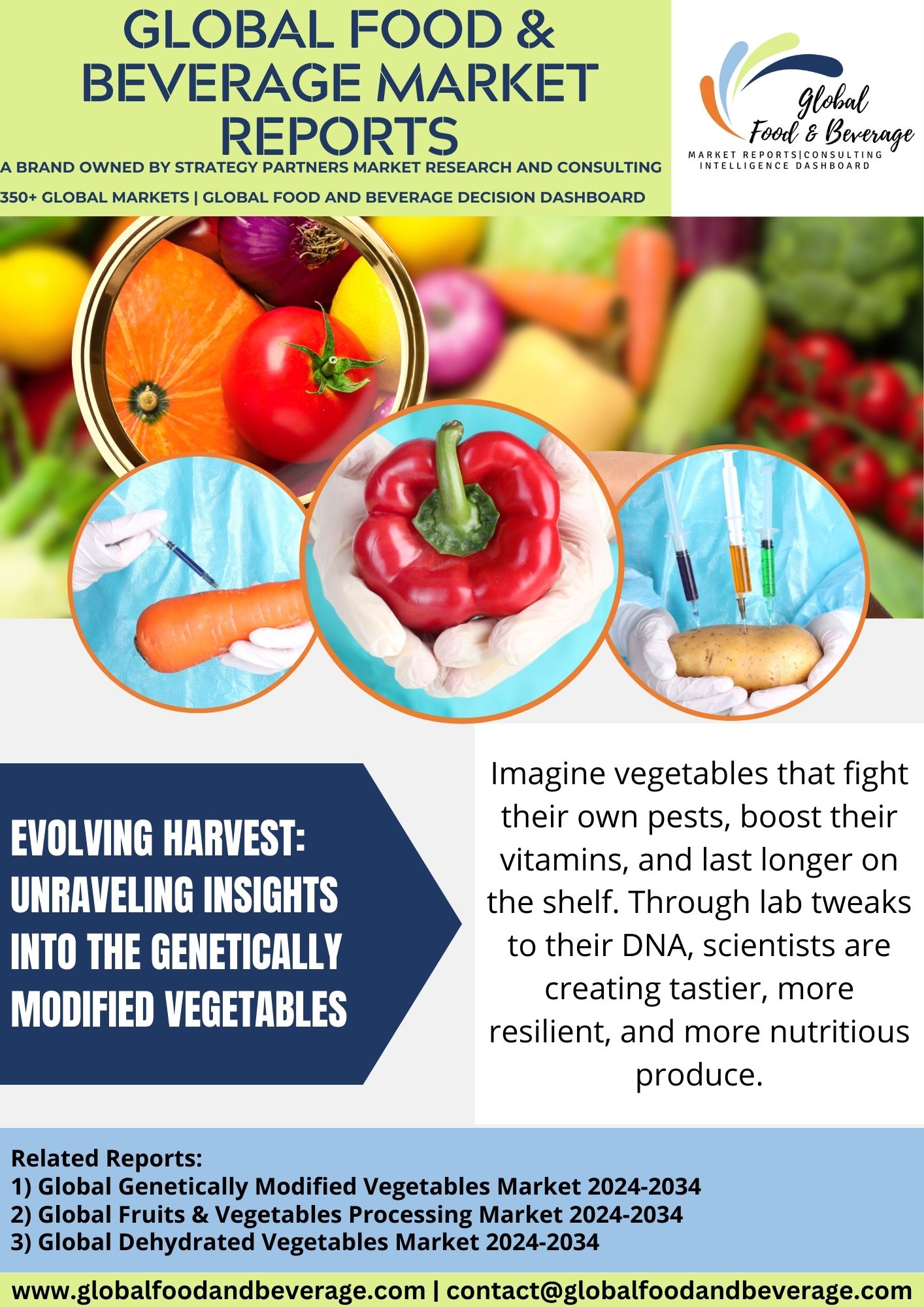Genetically modified (GM) vegetables have become a significant topic in the agriculture and food industries, representing a form of crop improvement that involves the introduction of specific genetic modifications to enhance desirable traits. This technology allows scientists to selectively introduce or modify genes in plants, imparting traits such as resistance to pests, tolerance to herbicides, or improved nutritional profiles.

One of the primary motivations behind the development of genetically modified vegetables is to address challenges in agriculture, such as increased pest pressures and environmental stresses. Through genetic modification, plants can be engineered to express proteins that deter pests, reducing the need for chemical pesticides and promoting more sustainable farming practices. Additionally, genetic modifications can confer resistance to specific herbicides, allowing for more effective weed control.
Nutritional enhancement is another area of focus for genetically modified vegetables. Researchers aim to fortify crops with essential vitamins and minerals, addressing nutritional deficiencies in certain regions and populations. For example, genetically modified varieties of rice, known as Golden Rice, have been engineered to produce beta-carotene, a precursor of vitamin A, to combat vitamin A deficiency in developing countries.
Despite the potential benefits, the cultivation and consumption of genetically modified vegetables have sparked debates surrounding safety, environmental impact, and ethical considerations. Critics express concerns about the unintended consequences of genetic modifications, the potential for allergenicity, and the long-term environmental effects of releasing genetically modified organisms into ecosystems.
Supporters argue that rigorous testing and regulatory frameworks are in place to ensure the safety of genetically modified vegetables for both human consumption and the environment. They emphasize the potential for GM crops to increase yields, reduce the need for chemical inputs, and contribute to global food security.
The acceptance and regulation of genetically modified vegetables vary across countries, reflecting a complex landscape of scientific, economic, and cultural considerations. Some countries have embraced the cultivation of GM crops, while others have imposed restrictions or outright bans on their production.
ADVANCEMENTS
Genetically modified (GM) vegetables have undergone significant advancements, revolutionizing agricultural practices and addressing various challenges in crop production. One notable breakthrough is the development of genetically modified vegetables with enhanced resistance to pests and diseases. Through the introduction of specific genes, crops like Bt (Bacillus thuringiensis) cotton and Bt brinjal have demonstrated increased resistance to insect pests, reducing the need for chemical pesticides and promoting more sustainable farming practices.
Advancements in GM technology have also led to the creation of vegetables with improved tolerance to environmental stresses. Drought-tolerant and salt-tolerant varieties have been developed to withstand challenging growing conditions, contributing to increased agricultural resilience and the ability to cultivate crops in regions prone to water scarcity or soil salinity.
Genetic modifications aimed at enhancing nutritional content represent another notable advancement. Biofortified vegetables, such as Golden Rice enriched with pro-vitamin A, address micronutrient deficiencies in populations where traditional diets may lack essential nutrients. This innovation has the potential to improve public health outcomes, particularly in regions where vitamin A deficiency is prevalent.
The development of genetically modified vegetables with extended shelf life and reduced susceptibility to post-harvest losses is a focus of ongoing research. This could result in less food waste and greater availability of fresh produce for consumers.
Advancements in genetic engineering techniques, such as CRISPR-Cas9, offer precise and targeted modifications to vegetable genomes. This technology allows for the development of crops with specific traits, including improved flavor, texture, and nutritional profiles, meeting consumer preferences for high-quality produce.
CHALLENGES
Genetically modified (GM) vegetables face a spectrum of challenges, encompassing consumer perceptions, regulatory frameworks, environmental concerns, and coexistence with conventional and organic agriculture. One significant challenge revolves around public perception and consumer acceptance. Negative perceptions of GM technology, often fueled by concerns over safety, ethics, and the right to know, contribute to resistance and skepticism among consumers. Building trust through transparent communication and education is essential for wider acceptance.
Regulatory hurdles present challenges for the GM vegetable industry. Stringent regulations and varying approval processes across countries create barriers to global trade and market access. Navigating complex regulatory landscapes requires substantial investments, time, and collaboration between industry stakeholders and regulatory bodies to ensure compliance with safety standards and public health.
Coexistence with conventional and organic agriculture poses challenges due to concerns over cross-contamination and potential impacts on biodiversity. Developing effective strategies and best practices for coexistence is crucial to minimize the unintended presence of GM traits in non-GM crops and ensure the peaceful coexistence of different agricultural production systems.
Environmental concerns, such as the potential for gene flow to wild relatives or the development of resistance in target pests, are challenges for the sustainable deployment of GM vegetables. Implementing effective risk management strategies, including monitoring and stewardship programs, is essential to address these concerns and ensure the responsible use of GM technology.
Economic considerations also play a role in the challenges faced by GM vegetables. The costs associated with research, development, and regulatory compliance can be substantial. Ensuring that the benefits of GM technology, such as increased yields, reduced pesticide use, or enhanced nutritional content, outweigh the costs is essential for the economic viability of GM vegetable production.
CONCLUSION
Genetically modified vegetables represent a scientific frontier that elicits both curiosity and controversy. Engineered to enhance traits like resistance to pests or increased nutritional content, they offer potential solutions to global food challenges. While concerns persist regarding environmental impact and consumer acceptance, ongoing research and technological advancements continue to refine their safety and efficacy. The future of genetically modified vegetables hinges on transparent communication, stringent regulation, and a nuanced understanding of their implications. As the world grapples with food security, the coexistence of traditional and genetically modified crops may pave the way for a more resilient, sustainable, and nourished global food landscape.
